Aromatherapy pillows can greatly improve your sleep quality and reduce anxiety. Choose calming essential oils like lavender or chamomile, and dilute them properly with a carrier oil. Select breathable fabrics like cotton or linen for your pillow covers. Create DIY inserts with dried herbs and essential oils for a personalized touch. Try lavender-filled eye pillows for targeted relaxation. Clean your pillows regularly and rotate scents to prevent desensitization. Combine aromatherapy with meditation for enhanced benefits. Customize blends to address your specific needs, and store pillows properly to maintain their efficacy. By following these tips, you'll be on your way to anxiety-free nights and better sleep.
Choose Calming Essential Oils
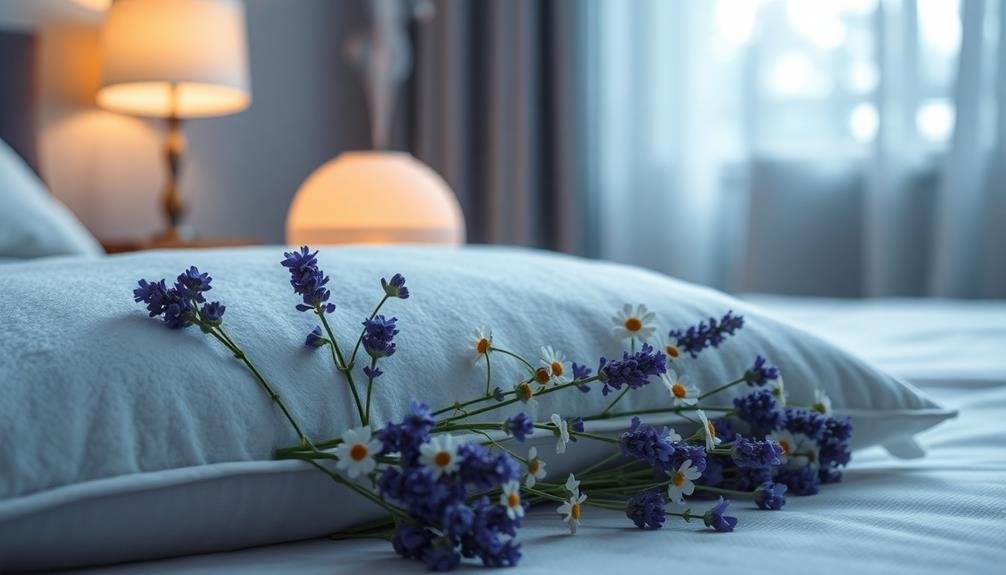
Selecting the right essential oils is crucial for creating an effective aromatherapy pillow. You'll want to focus on scents known for their calming and anxiety-reducing properties. Lavender is a top choice, renowned for its ability to promote relaxation and improve sleep quality. It's gentle and versatile, making it suitable for most people.
Another excellent option is chamomile, which can help soothe your mind and reduce stress. If you're looking for a slightly woodier scent, try sandalwood or cedarwood. These oils are grounding and can help quiet a racing mind.
For a fresh, uplifting aroma that still promotes relaxation, consider bergamot or ylang-ylang. When choosing oils, opt for high-quality, pure essential oils rather than synthetic fragrances. You can use a single oil or create a blend of complementary scents.
Start with just a few drops on your pillow or pillowcase, as essential oils are potent. If you have sensitive skin, dilute the oils with a carrier oil like jojoba or almond oil before applying. Always do a patch test first to confirm you don't have any adverse reactions.
Proper Dilution Techniques
When using essential oils in your aromatherapy pillow, it's vital to follow proper dilution techniques for safety and effectiveness.
You'll need to understand essential oil safety ratios, typically ranging from 1-5% dilution depending on the oil and intended use.
Choose a suitable carrier oil, such as fractionated coconut oil or sweet almond oil, to blend with your essential oils before applying them to your pillow.
Essential Oil Safety Ratios
Mastering proper dilution techniques is essential for safe and effective aromatherapy use on your pillow.
When it comes to essential oil safety ratios, you'll want to follow the general guideline of 1-2% dilution for adults. This means using 6-12 drops of essential oil per ounce (30 mL) of carrier oil or other base material.
For your aromatherapy pillow, you can create a safe and soothing blend by following these ratios:
- Light scent: 3-4 drops of essential oil per tablespoon of carrier oil
- Medium scent: 5-6 drops of essential oil per tablespoon of carrier oil
- Strong scent: 7-8 drops of essential oil per tablespoon of carrier oil
Carrier Oil Selection
The foundation of a successful aromatherapy pillow blend lies in choosing the right carrier oil. You'll want to select an oil that's lightweight, non-greasy, and absorbs easily into fabric. Some excellent options include sweet almond oil, jojoba oil, and fractionated coconut oil.
These carrier oils not only dilute essential oils safely but also nourish your skin as you sleep.
When selecting a carrier oil, consider its shelf life. Jojoba oil, for instance, has a long shelf life and won't go rancid quickly. If you have sensitive skin, you might opt for grapeseed oil, which is hypoallergenic and suitable for all skin types.
For added benefits, you can choose carrier oils with specific properties. Apricot kernel oil is rich in vitamin E and can help soothe dry skin, while avocado oil is deeply moisturizing.
Remember to patch test any new carrier oil on a small area of skin before using it in your pillow blend. This will help you avoid any potential allergic reactions.
Once you've chosen your carrier oil, you're ready to create a personalized aromatherapy blend that'll promote relaxation and anxiety-free nights.
Fabric Selection for Pillows
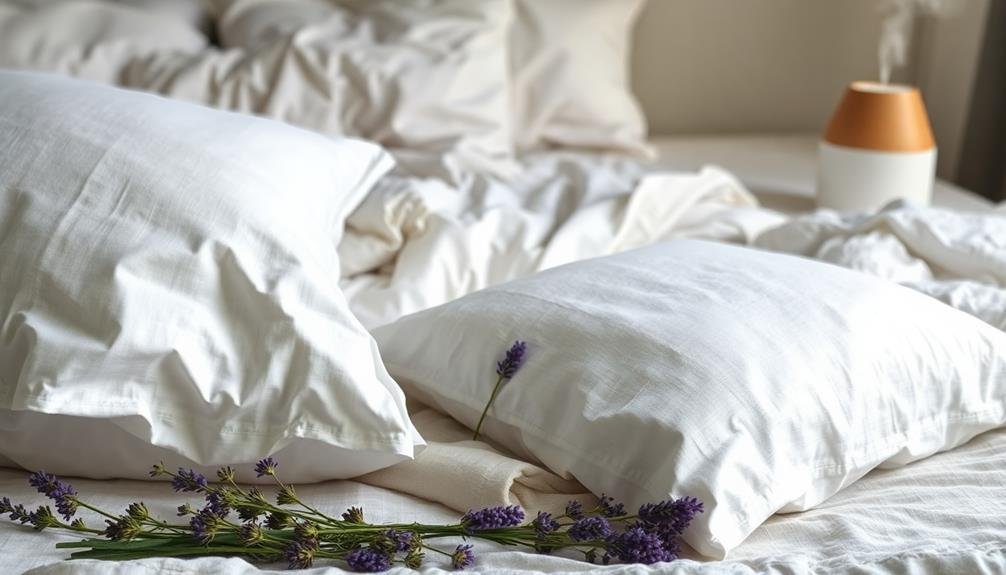
When choosing fabric for your aromatherapy pillow, you'll want to contemplate both natural and synthetic options.
Natural fabrics like cotton and linen are often preferred for their breathability and ability to absorb essential oils effectively.
However, don't overlook synthetic fabrics, as some blends can offer durability and ease of care while still allowing the aromatic benefits to permeate.
Best Fabrics for Aromatherapy
Selecting the right fabric for your aromatherapy pillow is essential to maximize its effectiveness. Natural fibers are your best bet, as they're breathable and can hold scents well. Cotton is a popular choice due to its softness and absorbency. It's also easy to wash, making it ideal for long-term use. Linen is another excellent option, known for its durability and ability to retain fragrances.
For a luxurious feel, consider silk or satin. These fabrics are smooth against your skin and can help reduce friction on your hair and face while you sleep. However, they may not hold scents as well as cotton or linen.
When choosing your fabric, imagine:
- The gentle caress of soft cotton against your cheek
- The crisp, cool touch of linen on a warm night
- The smooth glide of silk as you drift off to sleep
Avoid synthetic materials like polyester, as they don't breathe well and may not effectively release the aromatherapy scents.
Natural vs. Synthetic Options
Fabric choices for aromatherapy pillows boil down to natural versus synthetic options.
Natural fabrics like cotton, linen, and bamboo offer excellent breathability and absorption, enhancing the diffusion of essential oils. They're hypoallergenic and environmentally friendly, making them ideal for sensitive skin. Cotton, in particular, is soft, durable, and easy to wash, while bamboo provides natural antibacterial properties.
On the other hand, synthetic fabrics like polyester and nylon have their advantages. They're often more affordable, wrinkle-resistant, and quick-drying. Some synthetic blends are designed to wick moisture away, keeping you cool during sleep.
However, they may not absorb essential oils as effectively as natural fabrics and can sometimes trap heat.
When choosing between natural and synthetic options, consider your priorities. If you're focused on maximum aromatherapy benefits and eco-friendliness, natural fabrics are your best bet.
If you're budget-conscious or need specific performance features like moisture-wicking, synthetic options might suit you better. You can also explore blended fabrics that combine the benefits of both natural and synthetic materials, offering a balanced solution for your aromatherapy pillow needs.
Fabric Breathability Considerations
As you consider fabric options for your aromatherapy pillow, breathability should be a top priority. A fabric that allows air to circulate freely will enhance your comfort and guarantee the essential oils can diffuse effectively. Natural fibers like cotton, linen, and bamboo are excellent choices for their breathable properties.
Cotton is a popular option due to its softness and ability to wick moisture away from your skin. It's also hypoallergenic, making it suitable for those with sensitive skin.
Linen, while slightly more expensive, offers superior breathability and becomes softer with each wash. Bamboo fabric is eco-friendly and naturally antimicrobial, providing a cool and comfortable sleeping surface.
When selecting your pillow fabric, imagine:
- The gentle caress of a cool breeze on a warm summer night
- The crisp feeling of freshly laundered sheets against your skin
- The soothing comfort of a soft, breathable surface cradling your head
Avoid synthetic materials like polyester or nylon, as they tend to trap heat and moisture. Instead, opt for natural fibers that will complement your aromatherapy experience and promote a restful night's sleep.
DIY Aromatherapy Pillow Inserts
Crafting your own aromatherapy pillow inserts can be a rewarding and cost-effective way to enhance your sleep experience. You'll need a small fabric pouch, dried herbs, and essential oils to get started. Choose calming scents like lavender, chamomile, or ylang-ylang for anxiety relief.
To create your insert, fill the pouch with a mix of dried herbs and a few drops of essential oil. Experiment with different combinations to find your perfect blend. Here's a simple guide to get you started:
| Herb | Benefits | Essential Oil |
|---|---|---|
| Lavender | Relaxation, Sleep | Lavender |
| Chamomile | Stress Relief | Roman Chamomile |
| Rose Petals | Mood Enhancement | Rose |
Once you've filled your pouch, seal it tightly and place it inside your pillowcase. You can refresh the scent by gently squeezing the pouch or adding a few more drops of essential oil. Replace the herbs every few months to maintain potency.
Remember to use caution with essential oils, as they're highly concentrated. Always dilute them properly and avoid direct skin contact. With your DIY aromatherapy insert, you'll be on your way to more restful, anxiety-free nights.
Lavender-Filled Eye Pillows

While DIY pillow inserts can enhance your overall sleep experience, lavender-filled eye pillows offer targeted relaxation for your eyes and face.
These small, lightweight pillows are designed to rest gently on your eyes, providing a soothing aromatherapy treatment as you drift off to sleep or during meditation.
To use a lavender-filled eye pillow effectively, follow these steps:
- Lie down in a comfortable position and place the pillow over your closed eyes.
- Take slow, deep breaths, inhaling the calming scent of lavender.
- Visualize tension melting away from your face and neck as you relax.
The gentle pressure of the eye pillow can help relieve headaches, sinus pressure, and eye strain.
You'll find that the combination of weight and lavender scent promotes deep relaxation and eases anxiety.
For an extra treat, chill your eye pillow in the refrigerator before use to reduce puffiness and soothe tired eyes.
When choosing a lavender-filled eye pillow, look for one made with natural fabrics like silk or organic cotton.
Confirm it's filled with high-quality dried lavender buds for the best aromatherapy benefits.
With regular use, you'll likely notice improved sleep quality and reduced stress levels.
Rotating Scents for Maximum Benefit
Many aromatherapy enthusiasts find that rotating scents can maximize the benefits of their pillow inserts. By changing the fragrances you use, you'll prevent your brain from becoming desensitized to a single scent, ensuring continued effectiveness over time.
Start by selecting three to five different essential oils known for their calming properties, such as lavender, chamomile, bergamot, ylang-ylang, and sandalwood. Create a rotation schedule, using each scent for about a week before switching to the next. This variety will help maintain your interest and prevent olfactory fatigue.
You can also blend scents to create unique combinations tailored to your preferences. Mix lavender with vanilla for a soothing, sweet aroma, or combine bergamot and sandalwood for a grounding, woody scent. Experiment with different ratios to find your perfect blend.
Consider seasonal rotations as well. Use lighter, fresher scents like lemon or peppermint in spring and summer, and switch to warmer fragrances like cinnamon or frankincense in fall and winter.
This approach can help you align with nature's rhythms and enhance your overall sleep experience.
Cleaning Your Aromatherapy Pillows

To maintain the effectiveness of your aromatherapy pillows, regular cleaning is essential. You'll want to clean them every two to four weeks, depending on how often you use them.
Start by removing the pillow cover and washing it according to the manufacturer's instructions. For the pillow itself, spot clean any visible stains with a mild detergent and warm water.
To freshen up your aromatherapy pillow, follow these steps:
- Sprinkle baking soda over the entire surface and let it sit for 30 minutes to absorb odors.
- Vacuum the baking soda thoroughly, using the upholstery attachment to reach all crevices.
- Air out the pillow in direct sunlight for a few hours to naturally disinfect and deodorize it.
If your pillow has removable inserts containing essential oils, replace them as needed to maintain the desired scent intensity.
For pillows with built-in aromatherapy features, refresh the scent by adding a few drops of your preferred essential oil to a clean cloth and gently dabbing it onto the pillow's surface.
Remember to always use high-quality, pure essential oils to avoid any potential skin irritation or allergic reactions.
Combining Aromatherapy With Meditation
By combining aromatherapy with meditation, you'll create a powerful synergy for relaxation and stress relief. Start by choosing essential oils known for their calming properties, such as lavender, chamomile, or bergamot. Apply a few drops to your aromatherapy pillow before beginning your meditation practice.
Find a comfortable seated position and place your pillow within reach. As you settle in, take a few deep breaths, inhaling the soothing scents. Focus on your breath and allow the aromas to enhance your mindfulness. If your mind wanders, gently bring your attention back to your breath and the calming fragrances.
You can also incorporate your aromatherapy pillow into guided meditations. Hold the pillow close to your face during specific relaxation exercises or visualizations. This technique can help anchor your focus and deepen your meditation experience.
For an extra boost of tranquility, try a body scan meditation while lying down with your aromatherapy pillow. As you mentally scan each part of your body, the scents will promote a sense of calm and release tension.
Customizing Blends for Personal Needs
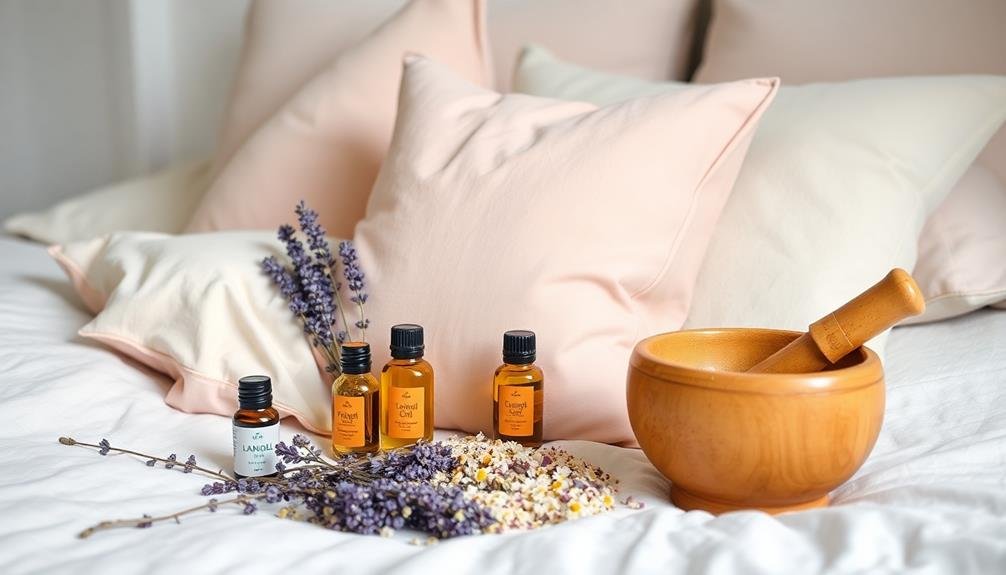
While pre-made aromatherapy blends can be effective, creating your own custom mix allows you to address your specific needs and preferences.
Start by identifying your primary concerns, such as anxiety, insomnia, or stress. Then, research essential oils known to target these issues. For anxiety, lavender, bergamot, and ylang-ylang are popular choices, while chamomile and valerian root can help with sleep.
Experiment with different combinations and ratios to find what works best for you. You might discover that a blend of lavender and bergamot soothes your mind, while adding a touch of cedarwood grounds you.
Keep a journal to track your reactions to various blends and adjust accordingly.
When creating your custom blend, visualize:
- A serene meadow filled with fragrant lavender swaying in the breeze
- A tranquil forest with towering cedarwood trees providing a sense of stability
- A sun-drenched citrus grove, with bergamot fruits releasing their calming aroma
Remember to always dilute essential oils properly and use high-quality, pure oils for the best results.
With patience and experimentation, you'll develop a personalized aromatherapy blend that transforms your pillow into a sanctuary of peace and relaxation.
Storage and Longevity Tips
Proper storage and care of your aromatherapy pillow are vital for maintaining its effectiveness and longevity. Keep your pillow in a cool, dry place away from direct sunlight when not in use. Sunlight can degrade essential oils and fade fabrics.
Consider using a breathable cotton pillowcase to protect the pillow while allowing the scent to diffuse. Refresh your pillow's scent every few weeks by adding a few drops of essential oils to the inner pouch or sachet. Don't oversaturate, as excess moisture can lead to mold growth.
Vacuum your pillow regularly to remove dust and allergens, which can interfere with the aromatherapy benefits. If your pillow has a removable cover, wash it monthly in cold water with a mild, unscented detergent. Air dry to preserve the fabric and avoid heat damage to any remaining essential oils.
For non-removable covers, spot clean with a damp cloth and mild soap. Replace the herbs or sachets inside your pillow every 3-6 months, depending on usage. This guarantees you're always getting the full therapeutic benefits of your aromatherapy pillow.
With proper care, your pillow can provide anxiety-free nights for years to come.
Frequently Asked Questions
Can Aromatherapy Pillows Help With Sleep Apnea or Snoring?
While aromatherapy pillows aren't a direct treatment for sleep apnea or snoring, they might help you relax and breathe easier. Some essential oils, like eucalyptus or peppermint, can potentially clear airways, but they're not a substitute for medical treatment.
Are Aromatherapy Pillows Safe for Pets in the Bedroom?
You should be cautious with aromatherapy pillows around pets. Some essential oils can be toxic to animals, especially cats. It's best to consult your vet and keep these pillows out of your pet's reach when using them.
How Long Does the Scent Typically Last on an Aromatherapy Pillow?
You'll find that scents on aromatherapy pillows typically last 2-4 weeks. However, it's not a one-size-fits-all answer. The longevity depends on the essential oil used, how often you sleep on it, and your pillow's material.
Can I Use Aromatherapy Pillows During Pregnancy?
You can use aromatherapy pillows during pregnancy, but it's vital to be cautious. Some essential oils aren't safe for expectant mothers. Always consult your healthcare provider first and stick to pregnancy-safe scents like lavender or chamomile.
Are There Any Potential Side Effects of Using Aromatherapy Pillows?
Yes, there can be side effects when using aromatherapy pillows. You might experience headaches, allergic reactions, or skin irritation. If you're pregnant or have respiratory issues, you should consult your doctor before using them. Always follow usage instructions carefully.
In Summary
You're now equipped with the knowledge to create a soothing sleep sanctuary using aromatherapy pillows. Remember, it's all about personal preference and what works best for you. Don't be afraid to experiment with different oils and blends. With consistent use, you'll likely notice improved sleep quality and reduced anxiety. Sweet dreams are just a whiff away! Keep exploring and refining your aromatherapy pillow techniques for the most restful nights possible.

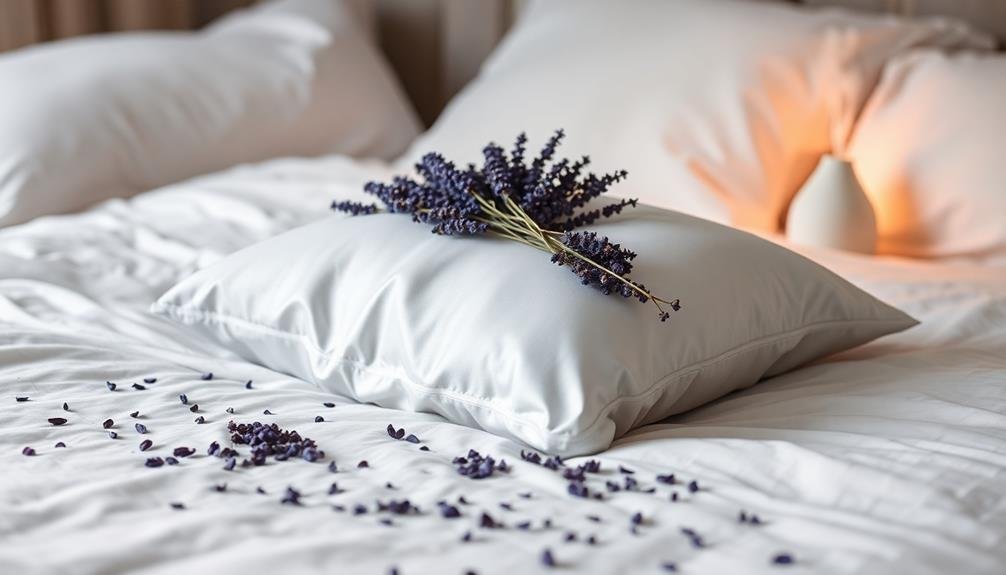

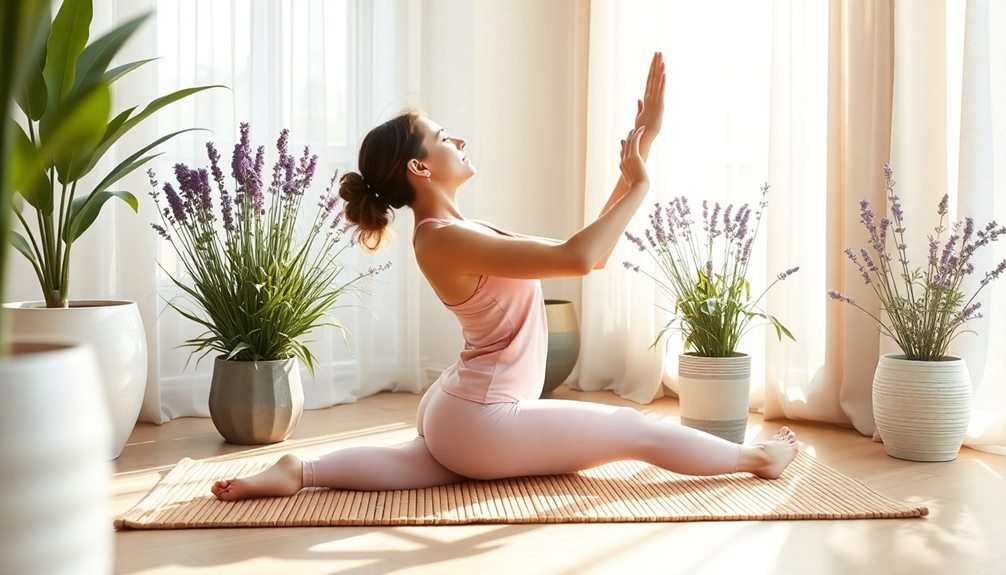

Leave a Reply